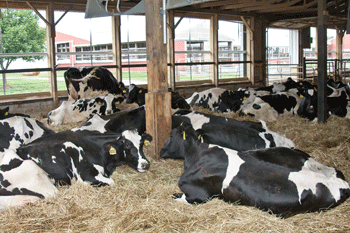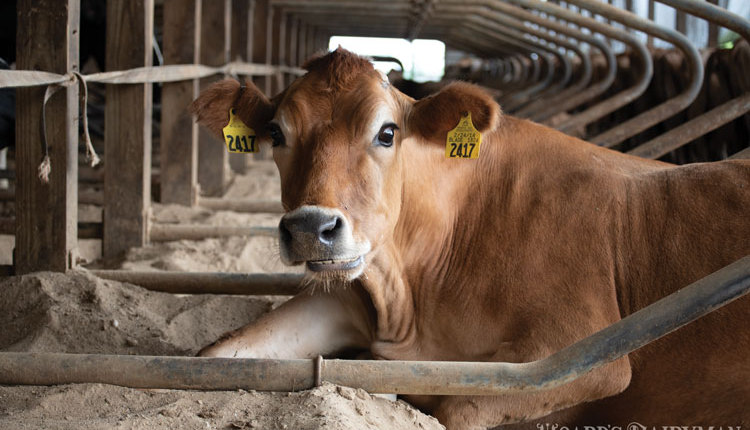Winkelman is a Ph.D. student at Cornell University in Animal Science. Nydam is a D.V.M. and is an assistant professor in Cornell's Department of Population Medicine and Diagnostic Sciences. Ospina is a D.V.M. pursuing her Ph.D. at Cornell University and is a lecturer in the Department of Animal Science. Overton is an associate professor in the Department of Animal Science at Cornell.

Feeding and handing close-up and just-fresh cows to minimize negative energy balance is vital to avoiding fresh cow problems and lost milk production.
Despite growing amounts of research about transition cow health and performance, we still are searching for solutions to find the best way to care for these cows during the window of time around calving. The days of the "old" steam-up rations have gone by the wayside, and we are learning more about transition cow care such as grouping and social interactions of first-calf heifers and older cows, and the impact of negative energy balance.
A large research study was conducted by Cornell University to look at the association between markers of negative energy balance, nonesterified fatty acids (NEFAs) and postpartum beta-hydroxybutyrate (BHBA), and cow performance, including disease incidence, milk production, and breeding performance. About 100 northeast free stall farms, with more than 250 cows, were enrolled in the study. All herds were feeding total mixed rations and had a sound record keeping system, either Dairy Comp 305, DHI, or both. Farms were given specific definitions for the transition diseases, including displaced abomasum (DA), clinical ketosis, metritis, and retained placenta.
Each farm was visited once at the beginning of the study at which time blood samples to evaluate pre- and postpartum NEFAs and postpartum BHBA were collected from two groups of animals. The team sampled approximately 15 healthy cows from the close-up group (those 14 to 2 days prepartum at time of sample collection), and a different set of 15 healthy cows were sampled from the fresh group (those 3 to 14 days in milk at time of sample collection). More than 2,700 blood samples were taken for the study, roughly representing 1,400 samples before calving and 1,300 after calving. About a third of the samples came from first-calf heifers, and the rest came from older cows.
Both NEFAs and BHBA are excellent markers to assess the overall energy status of the cow. It's no secret that, as cows get close to calving, their intake drops and usually is not enough to cover the high energy requirements in early lactation. When a cow dips (or dives!) into negative energy balance, blood NEFA and BHBA concentrations become elevated. Lots of money is being left on the table when cows have excessive negative energy balance during the transition period. An entire lactation's performance can be compromised in the three-week period before and after calving. This study shows the negative impact that negative energy balance (as measured by NEFA and BHBA) can have on health, milk production, and reproduction.
What was learned
In this study, cows with NEFA concentrations 0.3 mEq/L or above before calving were two times more likely to suffer from a transition cow disorder (such as a DA, clinical ketosis, or metritis and/or retained placenta) than cows with prepartum NEFAs less than 0.3 mEq/L. The same relationship was seen with postpartum NEFA and BHBA. Cows with postpartum NEFA concentrations 0.6 mEq/L or above were nearly five times more likely to suffer from a transition cow disorder, and those with BHBA concentrations 10 mg/dL or higher also were five times more likely to suffer from a transition disorder. Many other studies also have shown greater risk of disease with elevated BHBA and prepartum NEFA, but few have explored the association between NEFA after calving and the development of fresh cow problems.
Reproductive performance was measured by whether cows were pregnant within 70 days of the herds voluntary waiting period. In all groups of cows, the risk of pregnancy was reduced when the metabolites (NEFA or BHBA) were elevated. In close-up cows sampled, those with NEFA concentrations 0.3 mEq/L or greater had a 19 percent lower risk of pregnancy, those with postpartum NEFA 0.7 mEq/L or above had a 16 percent reduced risk, and those with BHBA 10 mg/dL or more had a 13 percent lower risk.
Although the association between NEFAs and BHBA and higher disease incidence and poor pregnancy rates is important, the most astounding effect observed in this study is the impact of elevated NEFA and BHBA on mature equivalent (M.E.) 305 milk production. In the close-up group, cows with NEFA concentrations 0.3 mEq/L or above produced 1,503 fewer pounds of M.E. milk than those with NEFA concentrations less than 0.3 mEq/L.
In the fresh cow group, heifers and cows responded differently to elevated NEFA and BHBA. Heifers with after-calving NEFA concentrations 0.6 mEq/L or higher and BHBA concentrations 9 mg/dL or higher produced 1,074 and 887 pounds more M.E. milk, respectively, than those with NEFA and BHBA concentrations below these thresholds. On the other hand, older cows with NEFA concentrations 0.7 mEq/L or more and BHBA concentrations 10 mg/dL or more produced 1,423 and 865 fewer pounds of M.E. milk.
It is likely that the best way to manage transition cow issues is at the herd level. Although the previous consequences are individual cow effects, we also investigated herd level effects of elevated NEFA and BHBA on disease, milk production, and reproductive performance.
What's your situation?
We established guidelines on when there is an opportunity to improve the negative energy balance in your herd during the transition period and reduce the negative consequences. There's room for improvement if more than 15 percent (two to three) of the sampled cows have close-up NEFA concentrations 0.30 mEq/L or higher, postpartum NEFA 0.70 mEq/L or higher, or BHBA concentrations 12 mg/dL or higher. Generally, the incidence of DAs and ketosis goes up by 2 percent, 21-day pregnancy rate goes down by 1 percent, and M.E. milk production by 1,200 pounds in cows and 600 pounds in heifers, at the herd level.
Here's how to identify whether negative energy balance is a risk factor that you need to address in your herd in order to improve transition cow care and minimize the negative health, reproductive, and milk production consequences. Sample 12 to 15 animals in the close-up period (14 to 2 days prepartum) and a different set of 15 head from the fresh cow period (3 to 14 DIM). If it is not possible to sample this many cows in one day (you don't have 30 head in the defined close-up and fresh cow periods), sampling in the shortest amount of time is ideal while taking note of any significant management changes that may affect results.
Blood BHBA concentrations can be measured easily cowside with a simple test meter and strip (http://www.abbottdiabetescare.com/; then select "Products," then select "Precision Xtra™ Blood Glucose and Ketone Monitoring System). While there currently is no cowside test available for NEFA, you can send blood samples to a lab, such as the Cornell Animal Health Diagnostic Center, and analyzed for less than $10 (contact your veterinarian for specifics).
Identifying whether negative energy balance plays a role in your transition cow program is just the first step. The next step is making the necessary changes that will help your transition cows. Next month we will review some of the areas of focus when addressing the overall care and housing of transition cows.

Feeding and handing close-up and just-fresh cows to minimize negative energy balance is vital to avoiding fresh cow problems and lost milk production.
Despite growing amounts of research about transition cow health and performance, we still are searching for solutions to find the best way to care for these cows during the window of time around calving. The days of the "old" steam-up rations have gone by the wayside, and we are learning more about transition cow care such as grouping and social interactions of first-calf heifers and older cows, and the impact of negative energy balance.
A large research study was conducted by Cornell University to look at the association between markers of negative energy balance, nonesterified fatty acids (NEFAs) and postpartum beta-hydroxybutyrate (BHBA), and cow performance, including disease incidence, milk production, and breeding performance. About 100 northeast free stall farms, with more than 250 cows, were enrolled in the study. All herds were feeding total mixed rations and had a sound record keeping system, either Dairy Comp 305, DHI, or both. Farms were given specific definitions for the transition diseases, including displaced abomasum (DA), clinical ketosis, metritis, and retained placenta.
Each farm was visited once at the beginning of the study at which time blood samples to evaluate pre- and postpartum NEFAs and postpartum BHBA were collected from two groups of animals. The team sampled approximately 15 healthy cows from the close-up group (those 14 to 2 days prepartum at time of sample collection), and a different set of 15 healthy cows were sampled from the fresh group (those 3 to 14 days in milk at time of sample collection). More than 2,700 blood samples were taken for the study, roughly representing 1,400 samples before calving and 1,300 after calving. About a third of the samples came from first-calf heifers, and the rest came from older cows.
Both NEFAs and BHBA are excellent markers to assess the overall energy status of the cow. It's no secret that, as cows get close to calving, their intake drops and usually is not enough to cover the high energy requirements in early lactation. When a cow dips (or dives!) into negative energy balance, blood NEFA and BHBA concentrations become elevated. Lots of money is being left on the table when cows have excessive negative energy balance during the transition period. An entire lactation's performance can be compromised in the three-week period before and after calving. This study shows the negative impact that negative energy balance (as measured by NEFA and BHBA) can have on health, milk production, and reproduction.
What was learned
In this study, cows with NEFA concentrations 0.3 mEq/L or above before calving were two times more likely to suffer from a transition cow disorder (such as a DA, clinical ketosis, or metritis and/or retained placenta) than cows with prepartum NEFAs less than 0.3 mEq/L. The same relationship was seen with postpartum NEFA and BHBA. Cows with postpartum NEFA concentrations 0.6 mEq/L or above were nearly five times more likely to suffer from a transition cow disorder, and those with BHBA concentrations 10 mg/dL or higher also were five times more likely to suffer from a transition disorder. Many other studies also have shown greater risk of disease with elevated BHBA and prepartum NEFA, but few have explored the association between NEFA after calving and the development of fresh cow problems.
Reproductive performance was measured by whether cows were pregnant within 70 days of the herds voluntary waiting period. In all groups of cows, the risk of pregnancy was reduced when the metabolites (NEFA or BHBA) were elevated. In close-up cows sampled, those with NEFA concentrations 0.3 mEq/L or greater had a 19 percent lower risk of pregnancy, those with postpartum NEFA 0.7 mEq/L or above had a 16 percent reduced risk, and those with BHBA 10 mg/dL or more had a 13 percent lower risk.
Although the association between NEFAs and BHBA and higher disease incidence and poor pregnancy rates is important, the most astounding effect observed in this study is the impact of elevated NEFA and BHBA on mature equivalent (M.E.) 305 milk production. In the close-up group, cows with NEFA concentrations 0.3 mEq/L or above produced 1,503 fewer pounds of M.E. milk than those with NEFA concentrations less than 0.3 mEq/L.
In the fresh cow group, heifers and cows responded differently to elevated NEFA and BHBA. Heifers with after-calving NEFA concentrations 0.6 mEq/L or higher and BHBA concentrations 9 mg/dL or higher produced 1,074 and 887 pounds more M.E. milk, respectively, than those with NEFA and BHBA concentrations below these thresholds. On the other hand, older cows with NEFA concentrations 0.7 mEq/L or more and BHBA concentrations 10 mg/dL or more produced 1,423 and 865 fewer pounds of M.E. milk.
It is likely that the best way to manage transition cow issues is at the herd level. Although the previous consequences are individual cow effects, we also investigated herd level effects of elevated NEFA and BHBA on disease, milk production, and reproductive performance.
What's your situation?
We established guidelines on when there is an opportunity to improve the negative energy balance in your herd during the transition period and reduce the negative consequences. There's room for improvement if more than 15 percent (two to three) of the sampled cows have close-up NEFA concentrations 0.30 mEq/L or higher, postpartum NEFA 0.70 mEq/L or higher, or BHBA concentrations 12 mg/dL or higher. Generally, the incidence of DAs and ketosis goes up by 2 percent, 21-day pregnancy rate goes down by 1 percent, and M.E. milk production by 1,200 pounds in cows and 600 pounds in heifers, at the herd level.
Here's how to identify whether negative energy balance is a risk factor that you need to address in your herd in order to improve transition cow care and minimize the negative health, reproductive, and milk production consequences. Sample 12 to 15 animals in the close-up period (14 to 2 days prepartum) and a different set of 15 head from the fresh cow period (3 to 14 DIM). If it is not possible to sample this many cows in one day (you don't have 30 head in the defined close-up and fresh cow periods), sampling in the shortest amount of time is ideal while taking note of any significant management changes that may affect results.
Blood BHBA concentrations can be measured easily cowside with a simple test meter and strip (http://www.abbottdiabetescare.com/; then select "Products," then select "Precision Xtra™ Blood Glucose and Ketone Monitoring System). While there currently is no cowside test available for NEFA, you can send blood samples to a lab, such as the Cornell Animal Health Diagnostic Center, and analyzed for less than $10 (contact your veterinarian for specifics).
Identifying whether negative energy balance plays a role in your transition cow program is just the first step. The next step is making the necessary changes that will help your transition cows. Next month we will review some of the areas of focus when addressing the overall care and housing of transition cows.







